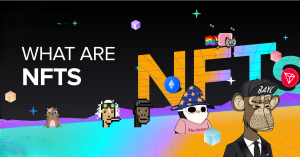Art /Entertainment
How Entertainment Industry Are Leveraging NFTs for Growth

Introduction
The entertainment industry has always been quick to embrace innovations that enhance audience engagement and boost revenue. Now, Non-Fungible Tokens (NFTs) are transforming this space by offering artists, creators, and businesses new ways to connect with fans. From digital collectibles to unique experiences, NFTs are reshaping how entertainment is consumed, collected, and monetized.
What Are NFTs and Why They Matter in Entertainment?

Image by: Yandex.com
NFTs, or Non-Fungible Tokens, are unique digital assets stored on a blockchain. Unlike cryptocurrencies, NFTs cannot be exchanged on a one-to-one basis because each token represents something unique. In the entertainment industry, this uniqueness allows creators to produce exclusive digital assets, such as limited-edition art, music, or virtual event tickets. The ownership is verified through blockchain technology, ensuring authenticity and creating value.
The Rise of NFTs in the Entertainment Industry

Image by: Yandex.com
NFTs are becoming more popular in the entertainment industry. They offer a new way for artists, musicians, filmmakers, and other creators to share their work and connect with fans. By using blockchain technology, NFTs make it possible to own digital items that can’t be copied, creating excitement and new opportunities. As more people understand NFTs, the entertainment industry is finding creative ways to use them to grow and reach new audiences.
NFT Applications in Different Entertainment Sectors

Image by: Yandex.com
NFTs have multiple applications across various sectors within entertainment, including music, film, sports, and gaming. Here’s how different segments are integrating NFTs:
- Musicians are using NFTs to release exclusive tracks, albums, and virtual concert tickets. Artists can also offer unique collectibles, such as digital album covers or special behind-the-scenes content, adding a personalized experience for fans.
- Film and TV: Studios and creators use NFTs to release exclusive content, behind-the-scenes footage, and interactive experiences. Filmmakers can sell “digital tickets” or offer fan interactions, creating a new income stream outside traditional cinema.
- Sports: Sports teams and leagues are creating NFT collectibles, such as player cards or memorable game moments, providing fans with exclusive ownership. These NFTs often hold sentimental value and can also be traded, adding a layer of community engagement.
- Gaming: In the gaming industry, NFTs allow players to own in-game items like skins, weapons, and characters. Unlike traditional games, NFT-based assets give players true ownership, allowing them to trade or sell these items outside the game environment.
Benefits of NFTs for the Entertainment Industry

Image by: Yandex.com
NFTs bring many benefits to the entertainment world. For creators, they offer a new way to make money by selling unique digital content. Fans also benefit because they can own rare, exclusive items like music tracks, video clips, and special event tickets. NFTs help create a closer relationship between fans and creators, giving them more ways to interact and engage. Additionally, NFTs open up new revenue streams and allow creators to earn royalties when their NFTs are resold.
The integration of NFTs offers several benefits for the entertainment industry:
- Enhanced Fan Engagement: NFTs allow fans to own a part of their favorite artist or show, creating a closer bond between the creator and the audience.
- New Revenue Streams: With NFTs, artists and creators can generate income from direct sales or royalties on secondary markets whenever NFTs are resold.
- Ownership and Scarcity: Blockchain technology ensures that NFTs are unique and verifiable, creating a sense of scarcity that can increase value over time.
The Role of NFTs in Modern Entertainment

Image by: Yandex.com
NFTs are playing an important role in transforming entertainment. They allow musicians to release special, limited edition songs or albums, while filmmakers can sell exclusive content or digital tickets. In sports, teams can create collectible NFTs of player highlights or moments from games. Gaming has also been greatly impacted, with players now able to own in-game items like characters and skins. NFTs are changing the way entertainment is shared, consumed, and enjoyed.
NFTs: Making Digital Collectibles Unique and Valuable

Image by: Yandex.com
NFTs allow creators in entertainment to make digital items that are one-of-a-kind. Each NFT can be something special, like a limited-edition album cover, a unique video clip, or an exclusive piece of artwork. This uniqueness adds value and makes fans feel they own something rare. Because every NFT is linked to the blockchain, its authenticity is confirmed, and no two are exactly alike.
Connecting Artists and Fans on a Personal Level

Image by: Yandex.com
For fans, NFTs bring them closer to their favorite artists and performers. Buying an NFT is more than just making a purchase—it’s like holding a piece of their favorite show, song, or game. Musicians can release exclusive songs as NFTs, or actors can share special behind-the-scenes clips. This allows fans to feel a personal bond with the people they admire, creating a loyal fanbase willing to invest.
New Ways to Earn Money for Creators

Image by: Yandex.com
NFTs are creating fresh income opportunities for artists and companies. Unlike traditional products, NFTs can keep generating money through resale. Each time an NFT is resold, the creator might receive a percentage of that sale, known as a royalty. This extra income helps artists and companies keep up with the changing entertainment world, offering fans new experiences while supporting the creators behind them.
Overcoming Environmental and Legal Hurdles

Image by: Yandex.com
The rise of NFTs has also brought some challenges. Many NFT platforms use a lot of energy, which has raised concerns about their impact on the environment. To address this, some are exploring eco-friendly blockchain options that use less energy. There are also legal questions, like how copyright applies to digital items. As the industry grows, more clear guidelines and sustainable solutions will help NFT use become more widespread.
NFTs in Sports and Gaming: Adding More Value

Image by: Yandex.com
In sports, NFTs let fans own digital highlights or collectible cards featuring their favorite players. This has become especially popular in leagues like the NBA, where fans can buy and trade these digital moments. Gaming also benefits from NFTs, allowing players to own in-game items, like special weapons or character outfits, that they can sell or trade. NFTs bring a new level of involvement, letting fans and players own a real part of the action.
Challenges in Adopting NFTs in Entertainment
While NFTs offer many benefits, there are challenges too. One of the biggest concerns is the environmental impact, as some NFTs use a lot of energy to create and trade. This has led to growing calls for more eco-friendly solutions. Another challenge is the market’s unpredictable nature, with NFT prices sometimes fluctuating dramatically. Additionally, there are still legal issues, such as copyright protection and intellectual property rights, that need to be addressed as the industry continues to grow.
While NFTs present exciting opportunities, there are challenges:
- Environmental Concerns: Some NFTs use blockchain technology that consumes large amounts of energy, raising environmental concerns.
- Market volatility: The value of NFTs can fluctuate significantly, which might deter consumers from purchasing them as investments.
- Regulatory and Legal Issues: Since NFTs are a relatively new technology, regulatory frameworks are still developing, potentially impacting how they are sold and traded.
The Future of NFTs in Entertainment

Image by: Yandex.com
As NFTs evolve, they could offer even more interactive and immersive experiences in the entertainment industry. For example, fans might be able to buy NFTs that grant access to special events, character cameos, or customized content. Additionally, as technology improves, more energy-efficient blockchains are emerging, which may address current environmental concerns. By adapting to these changes, the entertainment industry could secure a new era of fan engagement and economic growth.
Comparative Table: Traditional Entertainment vs. NFTs
| Feature | Traditional Entertainment | NFT-Based Entertainment |
|---|---|---|
| Ownership | Limited ownership (tickets, subscriptions) | Verified digital ownership |
| Revenue Streams | Ticket sales, ads, and merchandise | Direct NFT sales, royalties, auctions |
| Fan Engagement | Passive viewing or attendance | Interactive and personalized experiences |
| Market Dynamics | Stable pricing | High volatility |
| Environmental Impact | Lower energy consumption | Energy-intensive (depending on blockchain) |
Analysis Table: NFT Adoption Across Entertainment Segments
| Entertainment Segment | Current Applications | Opportunities | Challenges |
|---|---|---|---|
| Music | Exclusive songs, album art | Direct artist-fan connection | Unpredictable retail value |
| Film and TV | Collectible content, tickets | Revenue outside of traditional theaters | Legal copyright issues |
| Sports | Digital collectibles, moments | Increased fan engagement and loyalty | Market saturation |
| Gaming | In-game assets, skins | True ownership and secondary market sales | Environmental impact |
Conclusion: The NFT Era in Entertainment
NFTs represent a transformative shift in the entertainment industry, providing new ways for artists and businesses to connect with audiences while creating additional revenue streams. While challenges exist, including market volatility and environmental concerns, the potential for growth is substantial. As the industry continues to experiment and adapt, NFTs are likely to become an integral part of entertainment, offering fans and creators new ways to experience and interact with content.
Art /Entertainment
Slope Game: Mastering Speed and Precision for the Challenge

Have you ever felt the need for speed, combined with the precision of a surgeon and the reflexes of a ninja? If so, then you’ve probably stumbled upon the addictively simple, yet fiendishly challenging , Slope game.
It’s a web-based game that has captivated casual gamers and hardcore players alike, with its endless descent, minimalist graphics, and heart-pounding gameplay.
This isn’t a game about complex storylines or intricate strategies; it’s about pure, unadulterated reaction time and spatial awareness. So, buckle up, and let’s explore how to master this exhilarating game.

Gameplay: A Symphony of Speed and Precision
The premise of Slope is deceptively simple: you control a ball, hurtling down an infinitely generated slope dotted with red blocks. Your goal? To survive for as long as possible, accumulating a high score in the process. Sounds easy, right? Wrong.
The ball is controlled solely by the left and right arrow keys (or ‘A’ and ‘D’ for those who prefer that configuration). Pressing these keys abruptly shifts the ball from side to side.
The catch is the speed. The further you descend, the faster you go, and the narrower the gaps between the blocks become. What starts as a leisurely roll soon becomes a frantic dance of reflexes, demanding lightning-fast decisions and impeccable timing.
The game constantly throws new challenges your way. The slope isn’t always straight; it curves, twists, and throws you into precarious angles. You’ll encounter speed boosts that amplify the sense of velocity, and often find yourself relying on split-second judgments to avoid careening into an unforgiving red block.
Adding to the tension, the game’s aesthetics contribute to the experience. The stark, geometric environment, combined with the pulsing electronic soundtrack, creates a mesmerizing and slightly hypnotic atmosphere.
It’s a world stripped down to its bare essentials, forcing you to focus entirely on the immediate challenge. You can locate the game and test your abilities at Slope.
Tips and Tricks: Conquering the Infinite Descent
While Slope is primarily about reflexes, there are a few techniques that can drastically improve your performance and help you climb the leaderboards (or at least beat your own personal best).
- Master the Short Tap: Resist the urge to hold down the arrow keys. Short, controlled taps are far more effective than prolonged presses. This allows for finer adjustments and prevents you from overcorrecting and smashing into a wall. Think of it like gently nudging the ball rather than violently shoving it.
- Anticipate, Don’t React: As your speed increases, reacting to obstacles becomes virtually impossible. Instead, try to anticipate upcoming turns and gaps based on the patterns of the blocks ahead. Look further down the slope to prepare for what’s coming.
This is when spatial awareness becomes relevant
- Embrace the Curves: Don’t fight the curves; embrace them. Use the momentum of the curves to your advantage, guiding the ball along the arc. Resisting the curve will often lead to losing control.
- Listen to the Music: The soundtrack isn’t just for ambiance; it provides subtle cues. Certain changes in the music can indicate upcoming obstacles or changes in the slope’s direction.
- Practice Makes Perfect (Seriously): This might sound cliché, but it’s incredibly true for Slope. The more you play, the better you’ll become at predicting patterns, reacting to changes, and controlling the ball at high speeds.
Don’t lose hope due to initial setbacks; perseverance is essential.
-
Pause Periodically: Slope requires a high level of concentration and quick reactions. Engaging in prolonged play can result in tiredness and annoyance. Take frequent breaks to refresh your mind and avoid exhaustion. A new viewpoint can frequently result in enhanced performance
Why It’s So Addictive
What makes Slope Game so enjoyable is its balance of frustration and reward. You’re never more than a few seconds away from a new run, and every improvement feels like a victory. Its minimal graphics and techno soundtrack create that irresistible “just one more try” feeling.
In an age of overly complex games, Slope stands out as a sleek, fast, arcade-style challenge that’s easy to start and hard to quit.
Conclusion: More Than Just a Game
Slope is more than just a simple web game; it’s a test of skill, a challenge to your reflexes, and a strangely addictive experience. Its minimalist design and straightforward gameplay belie its deep level of challenge and the satisfaction that comes from conquering the infinite descent.
Whether you’re a seasoned gamer looking for a quick burst of adrenaline or a casual player seeking a fun and engaging way to kill time, Slope offers something for everyone.
So, go ahead, give it a try. Just be warned: you might find yourself hooked. Good luck, and may your descent be long and prosperous!
Art /Entertainment
Custom Jewelry at Careems: Crafting Meaningful Expressions

Discovering the Art of Custom Jewelry at Careems
This article explores why custom jewelry is becoming so popular, what makes Careems a leader in the industry, and how choosing personalized pieces can create lasting value across generations.

Why Custom Jewelry Matters More Than Ever
In the past, people often purchased jewelry as part of tradition—weddings, birthdays, cultural celebrations. While this still holds true, modern buyers look for something deeper: individuality.
Custom jewelry allows people to shape their own story through design, craftsmanship, and emotion. Instead of wearing what everyone else has, customers can collaborate with expert jewelers to bring a unique vision to life.
There are several reasons why custom jewelry has become a preferred choice:
1. Personal Expression
Custom pieces reflect personality. Whether it’s a ring designed around a memory, a necklace inspired by a loved one, or earrings crafted to match one’s style, customers can design exactly what they imagine.
2. Emotional Connection
A custom design often carries sentimental meaning. Engagement rings, wedding bands, or anniversary gifts created uniquely for someone make the moment more special and memorable.
3. Higher Craftsmanship Standards
When creating custom jewelry, expert jewelers spend more time perfecting each detail. This often results in better quality than mass-produced items.
4. Long-Term Value
Custom jewelry pieces can become heirlooms. Families pass them down through generations, giving them historical and emotional importance.
In Sri Lanka, where tradition blends beautifully with modern style, these reasons make custom jewelry a growing trend among young buyers, travelers, and couples alike.
Careems: A Heritage Jewelry Store With Timeless Craftsmanship
When discussing premium craftsmanship in Sri Lanka, Careems is a name that consistently stands out. Established generations ago, Careems is more than just another jewelry store it is a symbol of trust and artistry. Many locals and visitors recognize it as one of the country’s most respected jewelers.
Careems built its reputation through:
• Skilled artisans
Their craftsmen have decades of experience in goldsmithing, gem-setting, and design. Sri Lanka’s long history with gemstones, especially sapphires, gives Careems access to expert teams who understand the art deeply.
• High ethical standards
Customers value transparency when buying gold, diamonds, or Sri Lankan sapphires. Careems prioritizes authenticity and responsible sourcing, an essential factor in today’s jewelry market.
• Personal service
Unlike large commercial stores, Careems gives customers a personalized experience. Their consultants guide clients through every step, from choosing stones to approving final CAD designs.
• Elegance through simplicity
Careems is known for designs that are refined, balanced, and timeless rather than overly flashy. This subtle sophistication appeals to customers looking for long-lasting beauty.
These qualities make Careems a preferred destination for anyone seeking custom jewelry that blends tradition with modern elegance
The Custom Jewelry Experience at Careems
Creating custom jewelry can feel overwhelming at first, especially for buyers who don’t know much about gem quality or design. But Careems simplifies the process, making it enjoyable and educational.
Here’s how the experience often unfolds:
1. Initial Consultation
Customers meet with a designer or consultant to share their idea. It could be a sketch, a Pinterest photo, or even a simple description. Careems listens carefully to interpret the vision accurately.
2. Selecting Materials
Next comes choosing gemstones and metals. Careems provides expert guidance on Sri Lankan sapphires, diamonds, gold purity levels, and other materials. Customers learn about quality grades, colors, clarity, and pricing.
3. Design Visualization
Using modern design tools, Careems creates 3D models or sketches so customers can see what the final piece will look like. This stage allows changes, adjustments, and refinements.
4. Crafting the Piece
Once approved, the piece moves into production. Skilled craftsmen work with meticulous care, from shaping the metal to setting the gemstones. Every detail is handcrafted to perfection.
5. Final Delivery
The completed piece is polished, inspected, and presented beautifully. Many customers describe this moment as emotional — especially when it’s for a proposal, wedding, or family celebration.
This clear, supportive process is one reason why Careems remains a top jewelry store for personalized creations.
Why Customers Prefer Careems Over Other Jewelry Stores
There are many jewelry shops in Sri Lanka, but Careems continues to attract customers both locally and internationally. Several factors explain this consistent preference:
❖ Authenticity and Trust
Careems has decades of experience, and its reputation has remained strong throughout the years. Customers trust them with important purchases like engagement rings and wedding jewelry.
❖ Focus on Quality, Not Mass Production
While many stores push ready-made designs, Careems specializes in meaningful custom pieces crafted to last a lifetime.
❖ Heritage Meets Modern Technology
They combine traditional craftsmanship with modern tools like CAD design, creating a blend of precision and artistry.
❖ Strong Customer Relationships
Many families return to Careems for generations, which says a lot about the store’s commitment to service and satisfaction.
❖ International Appeal
Tourists visiting Sri Lanka often choose Careems for high-quality gemstones — especially Ceylon sapphires, which are globally famous.
The Future of Jewelry: Personal, Meaningful, and Custom-Made
As the world becomes more digital, customers still crave human connection and meaningful experiences. Jewelry shopping is no exception. The rise of custom jewelry shows that people want pieces that match their identity, values, and memories.
Careems recognizes this shift and continues to innovate while protecting its rich heritage. Whether it’s a simple pendant or a luxurious engagement ring, the store ensures every custom creation is crafted with passion and precision.
In the years ahead, the demand for personalization will only grow. And as more customers seek authenticity and emotional value, Careems is well positioned to remain one of Sri Lanka’s most trusted jewelry stores.
Art /Entertainment
Coloring Pages: Powerful Tool for Focus and Emotional Call

Coloring pages look simple. Kids love them. Adults rediscover them. But do they actually strengthen focus and create calm? Many online articles repeat the same points. So here, I take you deeper—into the neuroscience, emotional regulation patterns, micro-habits, sensory pathways, and parenting psychology behind coloring pages.
This guide explores what many people overlook: coloring builds mental discipline, rewires emotional reactions, enhances sensory processing, and trains the brain to pause instead of panic.

Why Does the Brain Respond to Coloring So Quickly?
Coloring creates a unique neurological loop. Eyes scan shapes. Hands follow lines. The brain locks into the present moment. This synchronized rhythm forms a “single-task state”—the opposite of mental overload.
The Brain Loves Predictable Patterns
Your brain constantly predicts outcomes. Coloring offers shapes, boundaries, and repetition. These patterns give the brain a safe zone where it feels secure.
Coloring Activates the Focus Network
When someone colors, the dorsal attention network lights up. This network controls sustained focus. It strengthens like a muscle each time you color with intention.
Micro-Focus Training Happens Without Effort
Children struggle with long focus sessions. Coloring breaks focus into small, doable pieces—one shape at a time. Each completed shape forms a mini dose of achievement chemistry (dopamine).
How Coloring Reduces Stress Faster Than Meditation for Some People
Meditation demands stillness. Many people struggle with it. Coloring offers movement, structure, and a “guided calm.” That makes calming easier and more natural.
The Nervous System Shifts into Safety Mode
When you color, your breathing deepens. Muscles loosen. Heart rate slows. The vagus nerve senses this and signals the brain to calm down.
Coloring Creates Emotional Containment
Colors hold emotions. When someone feels anxious or scattered, choosing colors layout on amazon helps contain that chaos into a safe outlet.
Coloring Interrupts Overthinking Loops
Worry spirals break easily when the brain switches tasks. Coloring gives the brain a gentle, non-verbal pattern to follow.
What Makes Coloring an Attention-Building Habit for Kids and Adults?
Coloring builds the hidden foundations of attention—something few articles discuss.
Coloring Improves Visual Tracking Skills
Eyes follow shapes and edges. This improves reading fluency and screen focus.
Coloring Strengthens Fine Motor Endurance
Holding crayons builds control. Smooth strokes create hand stability. Kids who color show stronger handwriting and better pencil discipline.
Coloring Trains Impulse Control
Staying inside the lines demands patience. It trains the brain to slow down and think before acting.
How Coloring Helps Children With Emotional Regulation
Parents use coloring as a quiet-time activity, but its emotional impact goes deeper.
Kids Express Feelings Through Colors
A child may color storms when upset or bright shades when excited. This becomes emotional communication without words.
Coloring Builds a Calm-Down Routine
A coloring ritual predicts peace. Kids who follow calming routines develop stronger self-regulation.
Coloring Teaches Frustration Tolerance
Children learn to restart, fix errors, and stay patient—skills they need later in school and life.
Why Adults Gain Mental Clarity From Coloring Pages
Adults carry overloaded minds. Coloring gives structure to release mental clutter.
Coloring Creates a “Pause Point” in Busy Lives
When someone colors, the brain stops multitasking. This clears mental static.
Coloring Enhances Mindful Decision-Making
Picking colors trains the mind to make small, intentional choices. This skill slowly expands into bigger life choices.
Coloring Strengthens Creative Confidence
Adults often fear creativity. Coloring removes pressure and builds creative self-trust.
How Different Coloring Styles Influence Focus and Calm
Mandalas Build Deep Focus
The circular symmetry pulls the brain inward, increasing concentration.
Nature-Themed Pages Support Relaxation
Trees, leaves, and animals evoke emotional safety.
Abstract Designs Activate Creativity
They free the mind to explore without rules.
Character Coloring Pages Boost Joy
Familiar characters like Superman, Spiderman, or Sonic coloring pages create emotional comfort, especially for children.
How Long Should You Color for Maximum Benefit?
Kids
10–15 minutes daily builds strong emotional and cognitive habits.
Teens
15–25 minutes resets their overwhelmed attention system.
Adults
20–30 minutes improves clarity, stress reduction, and mental discipline.
Coloring vs. Digital Apps: Which Strengthens Focus Better?
Paper Pages Win for Focus
Paper removes digital distractions. The brain stays anchored in the moment.
Digital Apps Work for On-the-Go Calm
They give instant access, especially for busy adults.
Best Approach
Mix both. Paper for deep focus. Digital for quick relaxation.
The Science Behind Color Choices and Mood
Colors shape emotions, and we instinctively choose tones that reflect our psychological needs.
Blue
Creates calm and mental clarity.
Green
Refreshes the mind and supports emotional balance.
Yellow
Boosts motivation and optimism.
Red
Increases alertness and energy.
Purple
Encourages creativity and imagination.
How to Use Coloring Pages as a Daily Calm Ritual
Create a Small Coloring Corner at Home
One notebook, a few crayons, and a quiet corner change the flow of your day.
Pair Coloring With Breathing
Take slow breaths as you color small shapes.
Make Coloring Part of Your Morning or Night Routine
Morning coloring boosts focus.
Night coloring prepares the mind for sleep.
Conclusion
Coloring pages offer more than entertainment. They train the brain to focus, calm emotional storms, and build creative confidence. Coloring helps kids manage feelings, adults relieve stress, and families reconnect in peaceful moments. You don’t need complex tools. You only need a pencil, a page, and a few minutes daily.
That small act can reshape attention, emotional patterns, and the ability to stay calm—one colored shape at a time.
-
Business2 years ago
Cybersecurity Consulting Company SequelNet Provides Critical IT Support Services to Medical Billing Firm, Medical Optimum
-
Business2 years ago
Team Communication Software Transforms Operations at Finance Innovate
-
Business3 years ago
Project Management Tool Transforms Long Island Business
-
Business2 years ago
How Alleviate Poverty Utilized IPPBX’s All-in-One Solution to Transform Lives in New York City
-
health3 years ago
Breast Cancer: The Imperative Role of Mammograms in Screening and Early Detection
-
Sports3 years ago
Unstoppable Collaboration: D.C.’s Citi Open and Silicon Valley Classic Unite to Propel Women’s Tennis to New Heights
-
Art /Entertainment3 years ago
Embracing Renewal: Sizdabedar Celebrations Unite Iranians in New York’s Eisenhower Park
-
Finance3 years ago
The Benefits of Starting a Side Hustle for Financial Freedom































